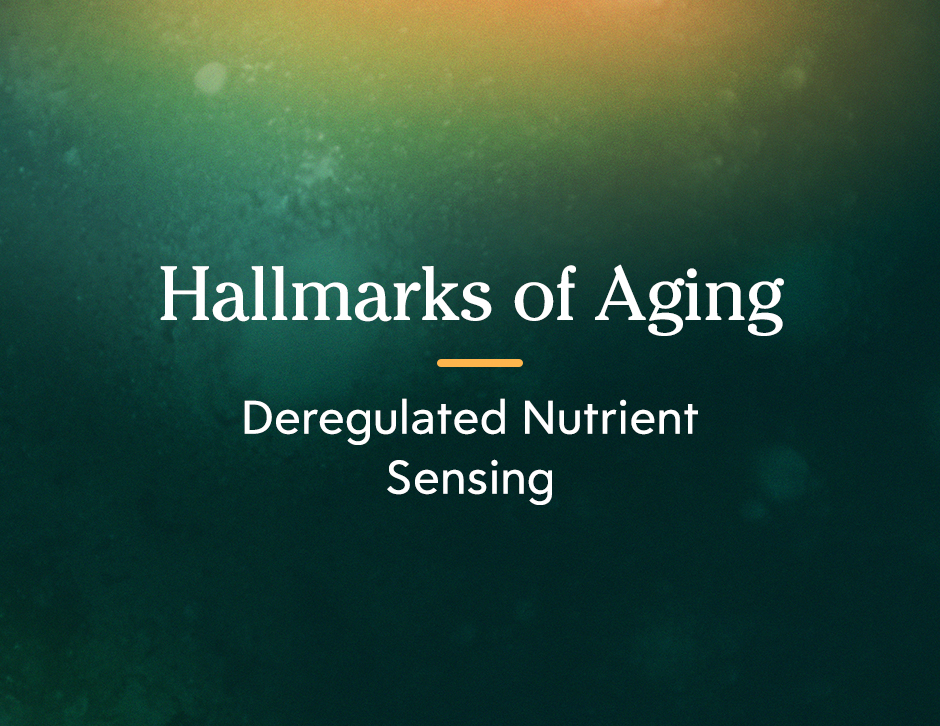
Quick overview of what you’ll learn from this blog post:
- What is deregulated nutrient sensing
- How it happens
- The consequences of deregulated nutrient sensing
The Hallmarks of Aging describes deregulated nutrient sensing as the failure of the four pathways that regulate metabolism and control energy production. The four pathways activity is influenced by nutrient levels and they play an important role in aging. As we get older the pathways become dysfunctional and this is thought to be one of the reasons we age.
So, why is that important?
Metabolism is central to how we age
Our metabolism is central to everything. How we use the nutrients we consume to produce energy for our cells and the myriad of functions they perform. Changes to nutrient availability, too much cellular activity, and stress can lead to deregulation and cause us to age quicker.
Because conditions and availability of nutrients vary greatly at any given time, we have evolved four nutrient sensing pathways. These pathways ensure that our body takes in the correct amount of nutrition and fine tunes that delicate balance as conditions change. The pathways work together to achieve a state of metabolic balance known as homeostasis.
The four pathways controlling metabolism are:
- The insulin/IGF-1 (IIS) pathway
This pathway is regulates a variety of functions required for metabolism and growth. It also plays a role in the fertility of multiple species, including flies, nematodes, and mammals. Reducing the activity of this pathway may also increase lifespan. - The mTOR (mechanistic target of rapamycin) pathway is a key regulator of metabolism and physiology. It plays a critical role in the function of tissues such as liver, muscle, brain, and white and brown fat. Elevated levels of mTOR are associated with diseases such as diabetes, obesity, and some cancers.
- Sirtuins are a family of signaling proteins that regulate metabolism and are widely thought to play a role in longevity. They are ancient and highly conserved in all kingdoms of life including humans. Sirtuin 6 is perhaps the most studied of the sirtuins in the context of aging and longevity. Some studies suggest that increasing the activity of sirtuin 6 may increase lifespan, but this is hotly debated.
- AMPK (activated protein kinase) plays an important role as a regulator of cellular energy homeostasis. It also regulates lipid metabolism, inhibiting the creation of fatty acids, cholesterol, and triglycerides. It also controls the uptake of fatty acids and their breaking down into energy. AMPK activates in response to stressors that deplete cellular energy supplies, including low glucose levels, heat shock, hypoxia, and ischemia.
How does our metabolism become deregulated?
Even under ideal conditions, our metabolism produces byproducts and waste that can damage our cells. This damage can occur in various ways and once it exceeds our ability to deal with it, it leads to deregulation of these nutrient sensing pathways. Some examples of this are:
- Endoplasmic reticulum stress
This happens when the capacity of the ER to fold proteins becomes compromised. The endoplasmic reticulum is a cellular organelle that directs the folding and transport of proteins. ER stress supports the accumulation of misfolded proteins, which can cause age-related diseases such as Alzheimer’s disease. - Oxidative stress
Oxidative stress is an imbalance between reactive oxygen species and antioxidants in our bodies. Reactive oxygen species are a byproduct of oxygen metabolism and under normal circumstances, they play an important role in cell signaling. However, oxidative stress upsets that balance, triggered by sources such as UV radiation, drugs, pesticides, cosmetics, flavorings, fragrances, food additives, industrial chemicals, tobacco smoke, and environmental pollutants. - Mitochondrial dysfunction
As we age the mitochondria responsible for producing energy from the food we eat can begin to behave in a harmful way due to mutations and damage to their DNA. In particular, mitochondria leads to increased oxidative stress and free radicals—a natural byproduct of normal mitochondria function. However, as we age, they produce more and more reactive oxygen species which drives inflammation and can further damage the mitochondrial DNA.
What can we do about deregulated nutrient sensing?
Don’t worry, things aren’t as daunting as it might seem when it comes to deregulated nutrient sensing. Researchers are currently working on ways to solve this problem. There are even a few things you can do yourself to potentially slow down how fast you age.
- Metabolism boosting approaches such as NAD+
- Tracking changes to your metabolism and blood sugar with a CGM
- Reducing the activity of mTOR
- Increasing the activity of the sirtuins
- Reducing the activity of insulin/IGF-1 (IIS) pathway
- Fasting or caloric restriction
If researchers can find ways to keep our metabolism in balance for longer, it could help us to remain healthier for a longer period of our lives (known as healthspan) as well as slowing down aging and potentially increasing our lifespan. To date, the only approaches that have demonstrated some merit in doing this is caloric restriction and fasting. While the evidence does not exist to support increased human lifespan from these two things, there is a myriad of data supporting that they are beneficial to health when done correctly.
Note: The above statements have not been evaluated by the Food and Drug Administration. This product is not intended to diagnose, treat, cure, or prevent any disease.
